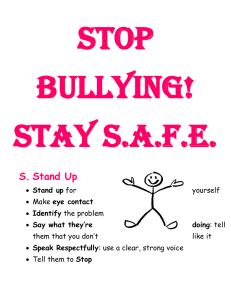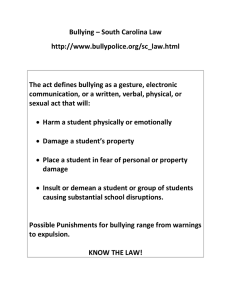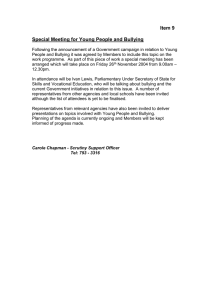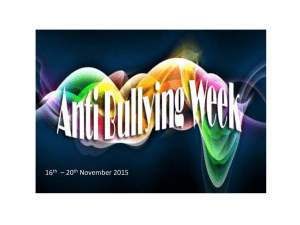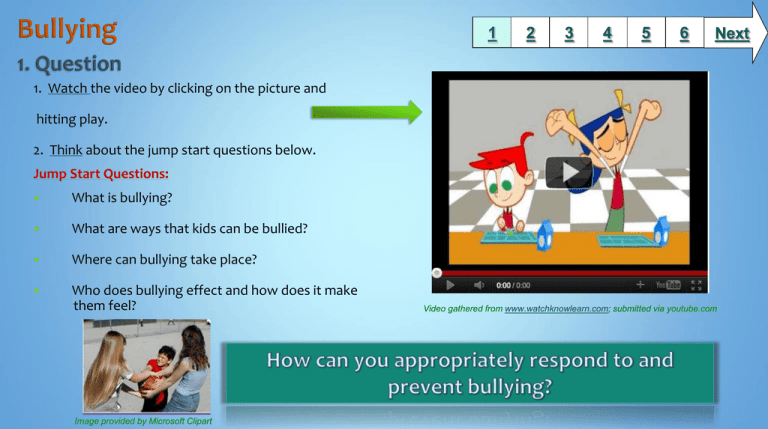
1
2
3
4
5
6
Next
1. Watch the video by clicking on the picture and
hitting play.
2. Think about the jump start questions below.
Jump Start Questions:
What is bullying?
What are ways that kids can be bullied?
Where can bullying take place?
Who does bullying effect and how does it make
them feel?
Image provided by Microsoft Clipart
Video gathered from www.watchknowlearn.com; submitted via youtube.com
1
2
3
4
5
6
Next
Let’s learn a little more about bullying and how it can affect the
way you feel and act. As you explore, fill in your
Note taking sheet
Click on the BrainPOP, Jr. or BrainPOP movie to the right to watch Annie
and Moby or Tim and Moby teach you about bullying. After you watch
the movie, click on the star to take an online quiz. Print out your quiz
results.
Listen to kids like you talking about what bullying is, how it feels to be
bullied, and what you can do!
- To get to these movies, click on the picture to the right. Select “Share ”
and then “videos”.
- Continue to explore the site for more great information about bullying!
Image retrieved from BrainPOP Jr., BrainPOP
*NOTE: Go to the BCPS Database page and click on BrainPOP Jr. or
BrainPOP, then return to this slide and click on one of the video links
above.
Read more about what bullying is and how you can deal with bullying by
reading and/or listen to the articles below.
Click the
symbol on the web page to have the article read to you!
Image retrieved from http://kidshealth.org/kid/feeling/emotion/bullies.html
Image retrieved from http://www.pacerkidsagainstbullying.org/#/home
1
Click on “Play” then “more games” then
“feelings” to use what you have learned
about bullying to identify the emotions
felt by a bullying victim.
Below the game, read the article “Bully
Beware” to learn more about preventing
bulling, as well as guidelines of how to
respond to a bully.
2
3
4
5
6
Next
1
Ready, Set, Action! Work with a partner or a small group
to write a commercial about bullying.
Read the rubric to see what you must include in your
project and how you will be graded.
2
3
4
5
Click the picture below for
an an Anti-Bullying
Commercial already on
T.V.
Click here
for a
Rubric!
Click on the “No Bullying” sign below to complete your
“Stop Bullying Now” comic strip script.
Image provided by Microsoft Clipart
6
Next
1
2
3
Use the Destiny catalog to
find more books and
resources about bullying.
4
5
6
Next
Answer question about
bullying to “beat the bully”
in a space race.
Watch “Stop Bullying Now”
webisodes that show
examples of bullying and
how they can be prevented.
Listen and sing along to a
song that uses positive
words to talk to a bully.
Draw a poster sending a
message about bullying.
Print it out to share with
others.
1
BCPS Curriculum:
Grade 3: Health
Module 1: Lesson 4 (Your Health Textbook, pg. 200-201)
Maryland State Curriculum
Standard 5.0: Safety and Injury Prevention
1. Identify teasing and bullying as harassment and their effects on the individual.
A. Recognize teasing and bullying.
B. Recognize examples of teasing and bullying, such as isolation name calling, and
other verbal assaults, and pushing and other physical assaults.
Common Core State Standards
Reading: 1. Read closely to determine what the text says explicitly and to make logical
inferences from it; cite specific textual evidence when writing or speaking to support
conclusions drawn from the text.
Writing: 7. Conduct short as well as more sustained research projects based on focused
questions, demonstrating understanding of the subject under investigation.
Standards for the 21st Century Learner
1.1.6 Read, view, and listen for information presented in any format (e.g. textual,
visual, media, digital) in order to make inferences and gather meaning.
2.1.3 Use strategies to draw conclusions from information and apply knowledge to
curricular areas, real-world situations, and further investigations.
Maryland Technology Literacy Standards for Students
3.0 : Use a variety of technologies for learning and collaboration.
2
3
4
5
6
Time Frame:
2- 60 minute periods.
Differentiation:
Students should be instructed to utilize the read aloud options on the
websites, as well as the captions tool on Brainpop,Jr..
This lesson can be taught as whole group or students can work with
partners. The assessments could also be completed in partners or small
groups.
Students may utilize their notes to complete each step.
Activity:
on level =
modified =
Learning Styles: sequential, global, reflective, kinesthetic, auditory and visual.
Notes to the teacher:
According to the BCPS Office of Health Education, this lesson should
be taught in the 1st quarter in the first Health Education Module.
Students can turn in activities by saving Microsoft
documents and copying it to a teacher or student drop folder.
If a computer lab is not available, this lesson may be implemented in
the classroom or library using interactive whiteboards and printed
handouts of the linked resources.
If the embedded video on slide one will not play, the teacher can use
the hyperlink to display the video on screen.
All assessments/notes can be printed out and handed in or saved to
the drop box for student files.
You may need to logon to Brainpop the first time. See your Library
Media Specialist for passwords.
Last update: July 2013
Created by Stacy Barry LMS, Edited by Ashley Weber PE/Health, Library Intern
BCPS Research Module or Slam Dunk Model, Copyright 2005, Baltimore County Public Schools, MD, all rights reserved. The models may be used for educational, non-profit school use only. All other uses, transmissions,
and duplications are prohibited unless permission is granted expressly. This lesson is based on Jamie McKenzie’s Slam Dunk Lesson module available at Dr. Jamie McKenzie's Slam Dunk Model.

